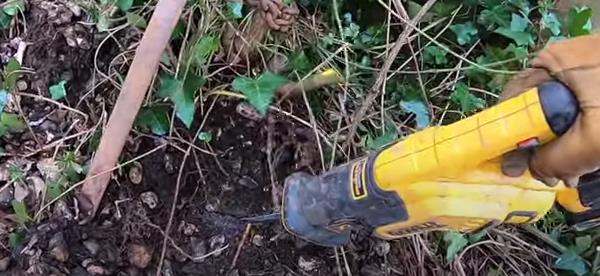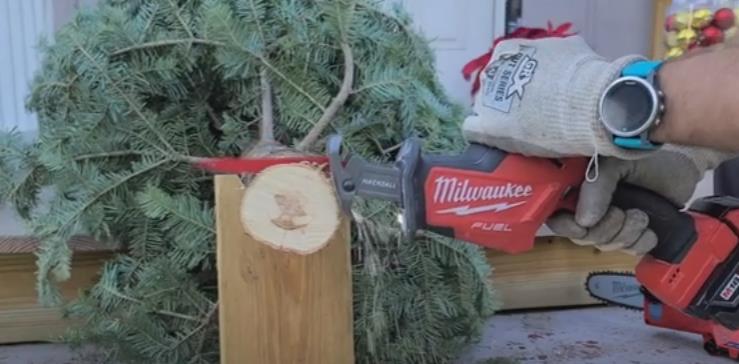Use a reciprocating saw with a metal cutting blade to cut roots.
A reciprocating saw is a multi-purpose tool that can be used to cut wood, metal, and plastic. Can I cut roots with a reciprocating saw?
Yes, you can cut roots with a reciprocating saw, but it is important to understand that this tool is not specifically designed for cutting roots and may not be the best option for all types of roots. The thickness and hardness of roots can vary greatly, so you need to choose a saw and blade that can handle the task.
This article will talk about what a reciprocating saw can and can’t do when cutting roots, as well as essential things to think about, techniques, and other options for anyone who wants to use this tool for this purpose.
What Is A Reciprocating Saw?
A reciprocating saw is a power tool that cuts through material by pressing and pulling a blade back and forth.
A reciprocating saw is a power tool that helps make quick work of a variety of projects, including cutting pipes, trimming wood, and more.
This type of saw gets its name from the reciprocating motion of the blade, which moves back and forth to make the cut. A reciprocating saw typically has a handle that the user can grip with one hand and a trigger that is squeezed to activate the blade.
There are a variety of blades that can be used with a reciprocating saw, depending on the material that needs to be cut. For example, a metal blade will be used for cutting pipes, while a wood blade can be used for trimming lumber.
One of the great things about a reciprocating saw is that it can be used in a variety of situations and is relatively easy to operate. If you need to make a quick cut, a reciprocating saw is a great option.
Can I Cut Roots With A Reciprocating Saw?

Yes, you can cut roots with a reciprocating saw. But before you begin cutting roots with a reciprocating saw, you should be aware of its capabilities and limitations. Even though reciprocating saws are strong tools that can cut through many different materials, they are not made to cut roots.
Roots can vary a lot in how thick they are and how hard they are, so cutting them needs to be done with care and precision. As a result, while a reciprocating saw can cut through some roots, there may be better tools for the job. Tree roots are critical to a tree’s overall health and stability. They absorb water and nutrients from the soil and serve as anchors for the tree.
A tree’s root structure can vary greatly, but it usually consists of a primary root and smaller lateral roots that branch off it. Because the size and location of roots can affect how difficult it is to cut them, it’s critical to understand the root system before attempting to cut any roots.
A reciprocating saw can be a great addition to your tool collection. It is a versatile tool that can be used for a variety of projects. With a little practice and some consideration, you’ll be making quick work of your to-do list in no time.
Considerations When Using a Reciprocating Saw to Cut Roots
There are several important factors to consider when using a reciprocating saw to cut roots:
- Power and Blade Size: It is critical to select a reciprocating saw with sufficient power and a blade that is appropriate for the job. Because the thickness and hardness of roots can vary greatly, you must select a saw and blade that can handle the job.
- Access to the Root: You must reach the roots to cut them. This means you may have to dig down to reach the roots, or you may have to use a longer blade to reach the roots from above ground.
- Precautions: When cutting roots, several precautions must be taken. Always wear protective equipment, such as eye protection and gloves, and never attempt to cut roots too large for the reciprocating saw.
Techniques for Cutting Roots with a Reciprocating Saw
When cutting roots with a reciprocating saw, use slow, steady strokes and position the blade correctly. Here are some pointers to cutting roots safely and effectively:
- Slow and steady cutting: Avoid cutting roots too quickly. Before applying any pressure, take your time and ensure that the blade is entirely in contact with the root.
- Proper Blade Positioning: Before beginning to cut, ensure that the blade is positioned correctly. This will allow you to make more precise cuts and reduce the risk of damaging the tree.
- Minimizing Tree Damage: It is critical to minimize tree damage when cutting roots. Cut roots that are too close to the trunk to avoid weakening the tree and increasing the risk of damage or collapse.
How to Use a Reciprocating Saw for Cutting Roots

Here are some steps to consider when using a reciprocating saw for cutting roots:
- Safety First: Always wear protective gear, including safety glasses, gloves, and a dust mask. Make sure the area around the tree is clear of any obstructions and that the tree is stable.
- Choose the Right Blade: Select a reciprocating saw blade that is appropriate for the thickness and hardness of the roots you need to cut. A high-carbon steel blade with aggressive teeth is best for cutting roots.
- Mark the Cutting Area: Use a pencil or marker to mark the area where the root needs to be cut. This will help you stay on track and minimize damage to the tree.
- Start the Cut: Place the blade of the reciprocating saw against the root and start the saw. Use a slow and steady motion, and apply just enough pressure to keep the blade cutting through the root.
- Adjust the Blade as Needed: If the blade becomes stuck in the root, gently wiggle it to free it and adjust the blade angle as needed to continue cutting.
- Finish the Cut: Once the root has been cut, turn off the saw and remove the blade from the tree. Inspect the cut area for any remaining pieces of root, and remove them if necessary.
- Aftercare: After cutting roots, it’s important to monitor the tree for any signs of stress or instability. Consider applying a sealant to the cut area to help prevent decay and promote healing.
Remember, always take care when using power tools and take the necessary safety precautions. If you’re unsure about using a reciprocating saw to cut roots, consider hiring an arborist or using specialized root cutting tools.
Alternatives to Using a Reciprocating Saw to Cut Roots
Can I cut roots with a reciprocating saw? The answer is yes. But if you’re not sure about using a reciprocating saw to cut roots, there are other options:
- Root Pruning: Root pruning is the process of carefully cutting roots to control their size and tree growth. This can be done with specialized tools like root saws and should be done by a qualified arborist.
- Hiring an Arborist: If you don’t feel comfortable cutting roots, you can hire an arborist to do it for you. An arborist has the experience, training, and tools needed to safely and effectively cut roots and can assist you in preserving the tree’s health and stability.
- Using Specialized Root-Cutting Tools: Specialized root-cutting tools, such as root saws and loppers, are available. These tools can be more effective than a reciprocating saw and can assist you in minimizing tree damage.
How Do You Use A Reciprocating Saw?
A reciprocating saw is a power tool that is used for cutting through materials such as wood, metal, or plastic.
Now that you know, can I cut roots with a reciprocating saw, you’re ready to tackle your next home improvement project. This versatile tool can help you quickly and easily complete a variety of tasks.
FAQ
How Do You Change The Blade On A Reciprocating Saw?
What Are Some Safety Tips For Using A Reciprocating Saw?
Final Words
A reciprocating saw is a powerful tool that can make quick work of many home improvement projects. But if you’ve never used one before, the prospect of operating this tool can be a bit daunting. The best way to cut roots with a reciprocating saw is to use a sharp blade and make sure to keep the blade perpendicular to the ground.
Whether you use a reciprocating saw or something else, it’s important to cut roots carefully and with knowledge. This can help keep the tree healthy and stable. Proper care and maintenance of trees are important for the health of trees and the environment as a whole.
Hopefully, you are now clear on can I cut roots with a reciprocating saw. If you still have any questions, feel free to comment below.





12 thoughts on “Can I Cut Roots With A Reciprocating Saw? The Guide For Safe Uses”
Comments are closed.